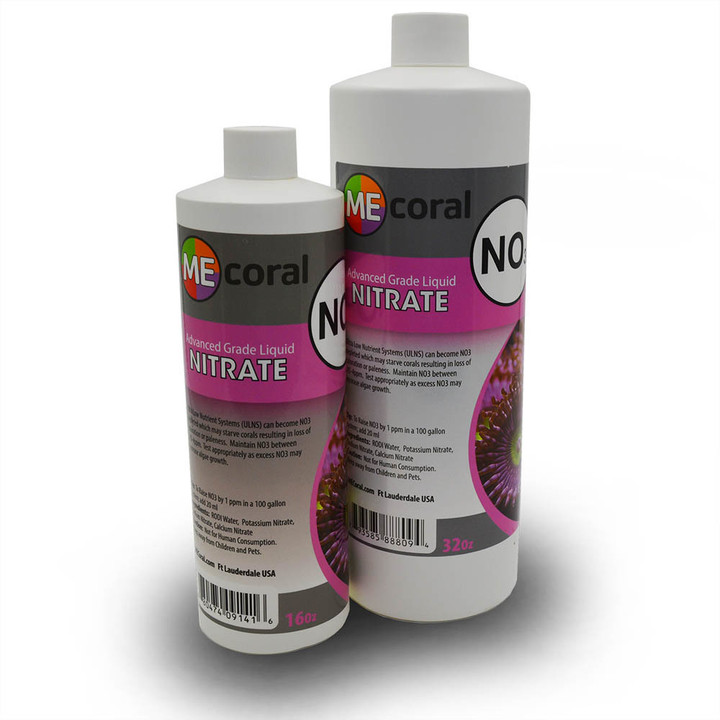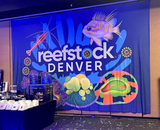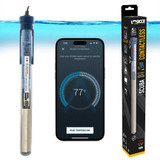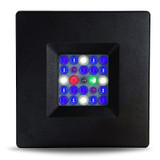Understanding Nitrate (No3) Supplementation For Corals
BY Mark Esquenazi of MECORAL Aug 2017
Listening to many reefers discuss their systems and what they are experiencing, we are hearing more frequently that some aquariums are ULNS (Ultra Low Nutrient Systems). Also phrased as, “Too Clean” a system. An ULNS refers to a system that is nutrient starved or nutrient deficient. Nutrients being Nitrates (No3) and Phosphates (Po4), both of which can be tested with some quality home aquarium test kits. If either No3 or Po4 reach very low to undetectable levels we can reach a point were corals, algae, bacteria and other microbial (Zooplankton, Pods, etc.) can’t eat enough to grow and multiply. As this lack of nutrients continues for a prolonged time, corals will show signs of starvation. SPS and other Corals begin to lose color and show signs of paleness. This lack of nutrients will also limit the growth of beneficial bacterial, coralline algae, and helpful microbial growing in our aquarium.
We have been taught from the day we built our system that we need the best nutrient reduction setup possible. Hence, the extra-large skimmer, huge refugium, growing green Chaeto, using custom algae scrubbers, Bio Pellets and more. Let’s not forget the importance of water changes to reduce nutrients. All of this is appropriate in a new system, or an overfed aquarium. Scientist would say a system “That has more input than output of nutrients.” As systems mature and bacteria and microbial colonies grow, along with our smarter feeding practices, we can reach a point that our nutrient reduction goes too far, or becomes too efficient. This leads to a potentially nutrient deprived system (ULNS). Or a system “That has more output than input of nutrients”.
If we reach this Ultra Low Nutrient level we can consider reducing our nutrient export methods, and increasing our feeding (or dosing) to increase nutrients. Before we turn off our nutrient export systems, we must understand their role and importance other than just nutrient reduction. Our skimmer does more than pull nutrients, it also aerates our tank water reducing CO2 in our system. The refugium grows beneficial pods and zooplankton. Our algae scrubber pulls toxic metals. Just turning off our nutrient export methods may not be the best way in the long run. Reducing some of these nutrient export methods slightly may be a more appropriate method.
The Redfield Ratio (107-17-1) teaches us that algae, phytoplankton, zooplankton, and most living sea life that feed on them as part of the food chain (we are what we eat) are made up of 107 Carbon, 17 Nitrate (No3), and 1 Phosphate (Po4). Subsequent scientist found the number to be much higher in Carbon and Nitrate. For our purposes, it doesn’t matter what the exact number is if we understand the main message. Corals, Algae, and bacteria need a ton of carbon and nitrate relative to phosphate. Corals can get most of their carbon via photosynthesis from sunlight, or good aquarium lights. This is not the case for beneficial bacteria and some microbial. That’s why some aquarist add (dose) carbon via vodka, vinegar, sugar, or bio pellets. Helping grow the bacterial colony in our aquariums, so they can eat more and reduce nutrients (No3 and Po4) further.
Since Corals have an abundance of Carbon from Sunlight; our focus turns to NO3 and PO4. The Redfield ratio shows that corals and bacterial need significantly more No3 than Po4. Approximately 17-25 times more nitrates getting consumed or removed from our aquarium than phosphates. So, most of our nutrient reduction systems will pull mostly No3 and a little bit of Po4. If this is not managed properly it can lead to zero nitrate, or a nitrate deficient system starving corals. Even if the PO4 level is above our target.
Feeding fish and corals is very important and beneficial. Some foods are better than others, read the ingredients. Feeding does increase nutrients. Our concern is that most fish foods will increase Po4 faster than No3. Not that quality food is made up of more Po4 than No3, but because our coral and bacteria and algae consume significantly more No3 than Po4, so the unconsumed Po4 remains in our system possibly raising our Po4 levels to undesirable levels while No3 gets reduced rapidly.
Elevated Po4 keep corals overfed which results in corals losing color, and SPS corals turning brown. High Po4 levels also bring undesirable algae growth. It is not elevated nutrients (both No3 and Po4) that inhibit coral growth and coloration. It is excess Po4 that slows growth and inhibits coloration. Our goal should be Po4 reduction not nutrient reduction. As we try to reduce Po4 we will typically reduce No3 much faster (Redfield ratio), hence, we push No3 to zero trying to reach our Po4 target (.02-.04ppm). This is where nitrate addition makes sense. If we can raise nitrate away from zero it will feed our corals, beneficial bacteria, coralline algae and other good microbial. As the bacteria grow and multiply rapidly, they will consume the nitrates we added along with some Po4. This leads to a reduction in Po4 in our systems. As po4 drops we can now feed our corals more fish or coral food without raising po4 above target. Corals do not get full and can eat more than we can imagine. Let them get fat fast! The reason we typically can’t feed more is because Po4 rise and discolor corals. By adding No3 we can reach a point that our feeding can increase without Po4 increases. This is the point of fastest coral growth. That is Low Po4 (.02-.04) with excessive coral feeding and detectable No3 level.
Which Nitrate to add is an area of controversy as there is no research on this in the aquarium world. It’s all reefers sharing with others via social media. Some started using products bought at gardening centers as nitrate is a plant fertilizer. Remember plants get carbon from the sun. No3 must be taken in via the roots. That’s fertilizer. Plants like corals flourish when fed properly. But, manure is a good fertilizer full of No3? So, is a nitrate a nitrate? No!! First there is a difficult quality issue. Then we can’t get No3 without getting something else. The most common forms are Potassium nitrate (KNo3). Sodium nitrate (SNo3), Calcium No3(CaN03), Magnesium No3 (MgNo3), etc. The problem with using only one nitrate form, is that we may raise the other element to undesirable levels, or above natural seawater levels. The best way is to create a blend of nitrates so we don’t raise something like potassium or sodium to elevated levels. The quality issue is challenging as nitrate is not typically sold for human consumption, so food grade or pharmaceutical grade becomes difficult or expensive to acquire. Look for a product designed for the aquarium trade that’s a blend of high quality nitrates. This is an area for the advanced hobbyist. Newer systems will not develop nitrate deprivation issues until bacteria colonies have matured.
Some points and pitfalls:
Poor Testing Bad data leads to bad analysis. Bad analysis lead to wrong corrective actions. Due to bad test results some people think they are at zero No3 and Po4 when in fact they have elevated levels of booth. Adding No3 in this situation may cause excess algae growth. Please understand how to use good quality, recently dated test kits.
Starting to FAST If we add No3 faster than it can get consumed it will lead to rapidly elevated No3 levels. What the exact target level for No3 is difficult to define as its system by system. Give time for your bacteria to grow. Start No3 additions slowly and then increase with time based on test results.
Abruptly Stopping If you have been dosing daily for months and suddenly stop it could lead to rapidly going to zero nitrates and corals paling due to starvation or lack of No3.
Quality matters Look for the highest quality product available as many plant fertilizers can have byproducts or toxic metals we do not need to introduce into our system. So, if it was designed to reduce stumps, or if was derived from cow manure then use it for what it was designed for. Look for a quality product designed for aquarium use. With proper dosing instructions. Check out ME-NO3. At MECORAL.COM
Explore Popular Articles
-
ReefStock Denver is This Weekend!
Feb 27, 2024The time is finally here. Reef Builders ReefStock Show is coming to the Crowne Plaza Hotel in Denve
-
Sicce's New Scuba Heater!
Oct 23, 20235 Year Warranty, High Quality Italian Made, A Heater for the FUTURE! Innovative heater range eq
-
Current USA R24 LOOP LED
Oct 23, 2023Compact lighting with SPS coral growing power. For those who love the Orbit® Marine, the Orbit® R





